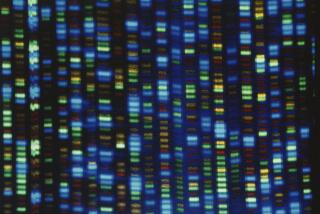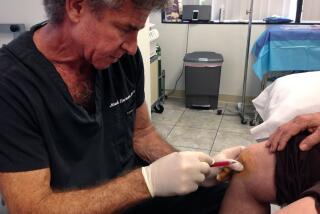Diabetes and the stem cell promise
Ever since scientists started talking about the medical potential of embryonic stem cells, curing Type 1 diabetes has been one of the dearest dreams.
When researchers announced in 1998 that they had derived stem cells from human embryos, their landmark report flagged juvenile-onset diabetes as a disease that might be treated by stem cell transplants.
In the run-up to the 2004 vote on California’s Proposition 71, diabetes was repeatedly mentioned as a target by scientists campaigning to form a state-backed stem cell agency.
Years later, the promise remains. But success has been elusive. Scientists are still studying how embryonic stem cells, which can develop into any type of cell in the body, can be coaxed to become cells that make insulin at just the right time, in just the right amounts, and that can be transplanted into patients to cure diabetes. Getting the cells to develop properly and figuring out how to administer them safely has been challenging.
“It’s maddeningly simple as a concept,” says Dr. Gordon C. Weir, a longtime diabetes researcher at the Joslin Diabetes Center in Boston. “It’s been incredibly frustrating that we can’t bring this to the clinic more quickly.”
Type 1 diabetes, once known as juvenile diabetes, is an autoimmune disorder that is usually diagnosed when patients are children or young adults. According to the Juvenile Diabetes Research Foundation, as many as 3 million Americans have the disease. They face a lifetime of vigilance, blood monitoring and daily insulin injections to keep the condition in check.
(More than 90% of people with diabetes have another form, Type 2 diabetes, which develops when the pancreas doesn’t produce enough insulin or the body becomes unresponsive to it.)
One reason why Type 1 diabetes seemed to be such a great fit for stem cell therapies was how motivated patients and their advocates were to find a cure, says Meri Firpo, a stem cell scientist at the University of Minnesota, Twin Cities. Groups such as the Juvenile Research Diabetes Foundation were willing to fund research using human embryonic stem cells — often controversial, because it involves destroying embryos — before other organizations were.
There were technical reasons too that made the disorder an attractive target, Firpo adds.
In Type 1 diabetes, for reasons not fully understood, a combination of genetic and environmental factors triggers a patient’s immune system to kill off his or her own beta cells, the insulin-producing factories that group together in the pancreas into clusters known as the islets of Langerhans.
Healthy people have about a million functioning islets in the pancreas, each comprised of about 1,000 beta cells. In Type 1 diabetes, those islets are destroyed. Restoring the islet cells would cure the disease — and researchers already know that they can do that. Scientists made the first successful islet cell transplant in 1989, placing beta cells from a cadaver into a diabetic patient.
The treatment, which is still considered experimental, isn’t perfect. Islet recipients must take anti-rejection drugs, which can lead to infection and organ damage, to prevent the body from attacking the foreign cells. Nonetheless, in the last two decades these transplants have greatly improved recipients’ diabetes to the point where some no longer require insulin injections, at least until their new beta cells peter out and a new transplant is needed.
If there were enough cadaver pancreases to go around, a better diabetes treatment would already be available. But there aren’t. About 35,000 people in the U.S. are diagnosed with Type 1 diabetes each year and only around 2,000 cadaver pancreases become available for transplantation, says Weir of the Joslin Center. One donor pancreas may not provide enough cells for even a single transplant, which has meant that only people with especially poor glucose control are candidates for the procedure.
But if scientists can figure out how to turn embryonic cells (or adult cells that have been transformed back to a versatile, embryonic state) into functioning beta cells, they’ll have access to a possibly endless supply for transplantation.
Researchers at a company called ViaCyte Inc. of San Diego have successfully nudged human embryonic stem cells to become precursors to beta cells. Transplants of those cells into mice have yielded promising results. Once implanted, the cells developed into beta cells and reversed diabetes in the animals.
But fine-tuning the cells to make them safe and effective for human use will take time. For example, beta cells do more than just produce insulin; they also respond to body cues to produce just the right amount of insulin when it’s needed and thus regulate glucose levels with great precision. If you make beta cells that produce too much insulin, the level of glucose can drop dangerously low — and people can pass out, lapse into a coma or even die.
“We have not regenerated the intricate mechanisms that regulate the levels of secretions,” says Matthias Hebrok, director of the UC San Francisco Diabetes Center. “Beta cells are like a Porsche — an amazing, calibrated machine. What we’ve made is more like a Volkswagen Beetle.”
Another major problem facing a cure in humans is the issue of autoimmunity — the problem that causes Type 1 diabetes in the first place. “Even if we are able to generate beta cells from stem cells, if you put them into a patient with Type 1 diabetes, they’ll be eliminated quickly, because the immune system is primed to destroy those cells,” Hebrok says.
Currently, physicians combat autoimmune responses with anti-rejection drugs. In the future, immunologists hope to figure out ways to specifically interfere with the interaction of the immune system and beta cells.
Another approach to the autoimmune problem is being tested by ViaCyte. The company is working on an embryonic stem cell-based therapy that will enclose beta-cell precursors inside a membrane envelope, then implant them under a diabetic patient’s skin. The pouch will allow insulin to flow out of it, into a patient’s bloodstream, but won’t allow cells of the immune system to get in and attack the implant (or allow rogue cancers from the transplant, should they arise, to escape into the recipient’s body).
Finally, diabetes researchers face the same challenges as any other scientists working with stem cells: They need to figure out how to produce large numbers of the beta cells and make sure they’re safe and stable.
Over the long term, the best solution would probably be to study how stem cells generate beta cells to figure out how to teach a patient’s body to regrow islets for itself from stem cells, and possibly even other types of cells, already in the body, Firpo says. “We could have stem cell therapies that don’t actually involve a stem cell being transplanted into a person.”
Weir, Firpo and Hebrok all say they can’t predict when stem cell therapies for diabetes might become available.
Hebrok adds that he isn’t discouraged, though. “To be honest, I think we’re amazingly fast. When I started in 1996, we really had no idea” how to produce beta cells, he says. “What we’ve learned in the past decade and a half is truly amazing.”
Still, the pace of progress can seem unbearably slow to some. The soonest ViaCyte’s technology would begin human trials would be 2013. Other proposed cures won’t be ready for testing until even further in the future.
“There was too much hype for this type of technology. There are no shortcuts in this kind of research,” says Dr. Camillo Ricordi, an islet cell transplantation expert at the University of Miami Diabetes Research Institute.
“Next century, when you look back at it, two decades won’t seem like much. But for those affected right now, every month is too long.”







